Nuances of planting pears in autumn
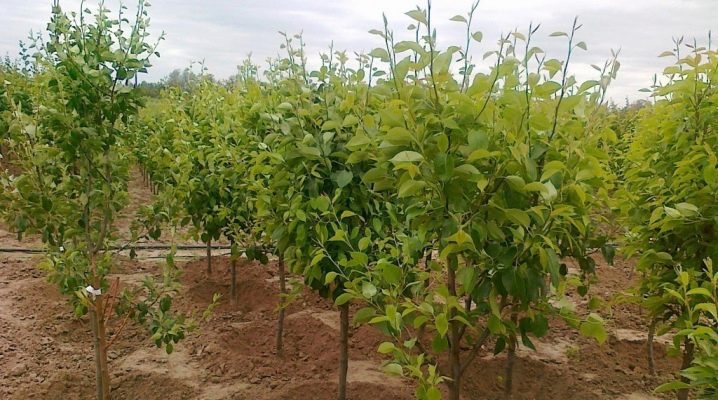
Spring or early autumn is considered a good time to plant pears. Experienced gardeners prefer the autumn season, because it is at this time that the plant has the opportunity to get used to new conditions and gain strength for the winter.
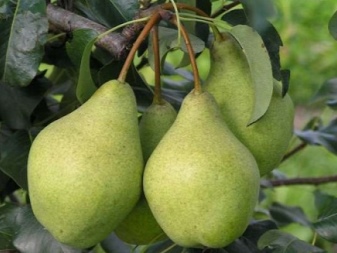

Advantages and disadvantages
The process of growing pears has its own characteristics. It requires certain skills and experience with fruit trees.
Planting pears in the fall has its advantages:
- over the summer, a large number of pear tree seedlings of various varieties appear in the nursery;
- by the fall, the seedlings will become stronger, they are already ready to adapt to a new place;
- the pear will adapt to new conditions and begin to grow actively in the spring, without fear of frost.
The disadvantage of autumn planting is the high risk that early frosts can harm a young seedling. Some specimens will not be able to withstand too low temperatures.
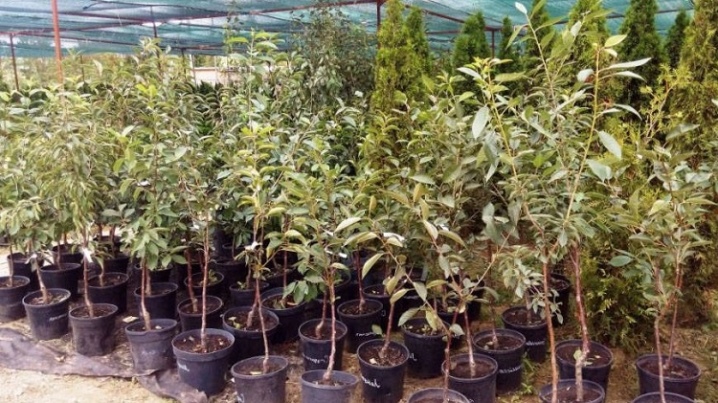
Timing
The timing of planting is greatly influenced by weather conditions and terrain. On the day of planting, warm, cloudy and at the same time dry autumn weather is considered favorable. Pear trees are planted in the evening. It is advisable to have time to do this a month before the cold snap. For example, in the Moscow region and in the middle lane, this culture is planted in September. For the Urals and Siberia, the best time will be the end of summer and the beginning of autumn. But for them it is better to give preference to frost-resistant varieties of pears. The southern regions have the opportunity to move the planting time to October. Many gardeners choose planting days based on the lunar calendar. It indicates favorable and unfavorable days for planting work.
If the seedling did not wait for planting in the fall, the cold began, then planting can be postponed until spring. For this, the seedling is stored so that it remains alive, but is not in the phase of active growth. The spine is wrapped with a cloth (cotton is suitable) moistened with water and placed in sawdust. Liquid is regularly added to the fabric so that the root does not dry out.
Dryness, coolness and darkness are important for storage.

Preparation
To begin with, in the garden area, they select a place for planting. A rather large space is left for a pear tree, because its crown diameter reaches six meters. The plant is planted in the southern and well-lit side of the site. The apple tree is a comfortable “neighbor” for this culture, because they have similar care requirements. It is undesirable to plant a pear tree next to a mountain ash, as plants can transmit diseases to each other. You should not place the pear near groundwater, as excess moisture has a detrimental effect on the roots. You can plant a tree on an artificial embankment or make drainage, then it is quite possible to avoid root rot.
The seedlings themselves are thoroughly examined before planting. All damaged or rotten fragments are pruned with pruning shears. All leaves are also removed so that the plant does not give up its resources to them, but directs all its energy for rooting. Before planting the pear, the dry roots are left in moisture for 24 hours, then they are dipped into a prepared mixture of clay and mullein with water. Then they are left in the fresh air for 30 minutes. And after that they are planted in a dug hole.
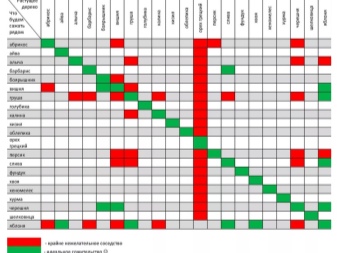
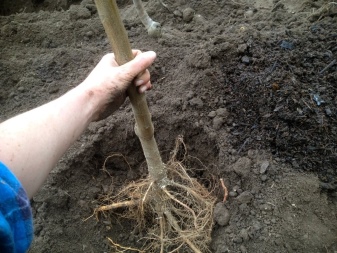
Priming
The tree is planted depending on the cardinal points. It is desirable in the same way as it grew in the nursery. It is possible to understand the location by the color of the bark: its light part points to the north side. For pear trees to grow well, the soil must be fertile, with a loose consistency.Excess clay in the ground can be dangerous for the tree. The pear feels great on loam and humus soil.
The upper part of the soil is carefully removed. It will come in handy later for filling the top layer. Then the landing pit is being prepared. Compost (8 kg per 1 sq. M), superphosphate (60 g per 1 sq. M), sand and limestone (if the soil is acidic) are added to one part of the soil. Humus is added to clay and peat soils, and they are also watered with a solution of dolomite flour. If the tree is planted in gray forest or sod-podzolic soil, fertilizers are applied in a larger volume.
It should be noted that fresh cow dung is not suitable for feeding a pear, since during decomposition it heats up and can burn the roots. Rotted poultry manure can be used for fertilization, as it has many nutrients and minerals. The resulting mixture is mixed with soil and poured into a pit.
Liquid mineral and organic fertilizers are usually added in spring or summer when plants are watered.
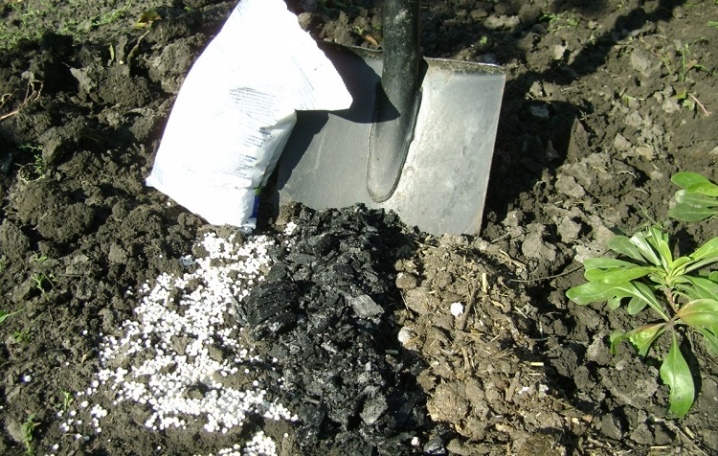
Pit
The pit for the tree should be prepared in advance. Even in the summer season, the site needs to be dug to the depth of the bayonet. Fertilizers can be added directly during digging: 6 kilograms of compost, 60 grams of superphosphate and 30 grams of potassium salt. If it was not possible to prepare the pit in the summer, you can do this in the fall. Of course, it is undesirable to do this just before landing. At the same time, fertilizer is also applied, in addition, the soil is watered.
The hole should be approximately 60 centimeters deep and 1 meter in diameter. The larger the pit, the better the plant will adapt to new conditions. If there is a layer of clay in the soil, the hole is made shallow. To prevent the roots from touching the clay, gardeners dig small furrows on four sides, about one meter long. These ditches are filled with organic waste that has been previously soaked in liquid fertilizer. In this case, the roots will be spread out to the sides to provide themselves with nutrition.
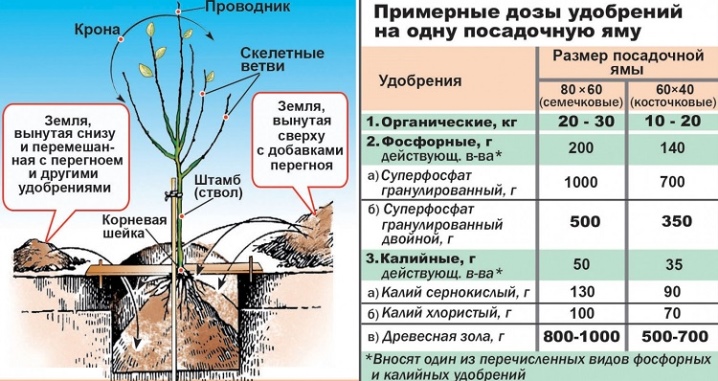
Technology
It is important to properly plant the seedling in open ground. For planting, take one-year-old or 2-year-old seedlings, no older. At the very bottom of the pit, an elevation is formed. The mound is compared to seedlings (their height). The position is correct if, after compacting the soil, the neck of the tree is 5-6 cm higher from the ground surface. The tree should be planted in the center of the pit. The roots must be straightened before backfilling with soil. The hole is covered with earth, but very carefully, in order to cover the entire space between the roots, but not to move the seedling itself. In order for the seedling to be stable and not topple over, you need to compactly tamp the soil near the trunk and tie the tree to a peg. The height of the peg is equal to the height of the lower branch of the tree.
There are some nuances in planting a pear with a closed root system. To begin with, the earth is watered with water and wait about 5-10 minutes until the earthy clod absorbs the earth. This way the seedling and soil will not decay when transplanting. Then the seedling is removed from the container. You need to take it by the bottom of the trunk, turning the container with the tree over, and carefully remove the plant. Then it will be thrown into a pit and covered with earth. A seedling with an open root system first needs to be examined well and the rot removed, then it is placed on an earthen mound, the roots are straightened along the mound, and the voids between the roots are filled with earth. After that, all the remaining space is covered with soil and tamped around the trunk.
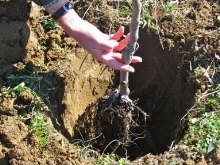

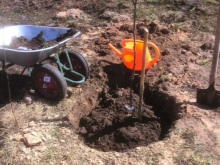
When the tree is planted, it should be watered with warm water. The liquid is poured directly under the spine. The tree takes about two or three buckets at a time. If the earth around the tree began to sink rapidly, you need to react in time, fill up and tamp the loose earth around the trunk. At the very end, the trunk circle of the pear tree should be mulched. You can use humus or dried leaves, sawdust or peat.
Let's consider other important rules.
- It is better to prepare the fossa in advance.
- Only young seedlings should be taken (not older than two years).It is important to check them for damage while still in the nursery.
- It is undesirable to land ahead of time.
- You don't need to plant your plants too high. So their roots will not deteriorate, it will be possible to prevent them from heating from the sun, weathering or freezing. Moreover, when the roots grow vertically, the plant takes root slowly and does not develop well.
- If you plant a seedling too deep, the plant will suffer from a strong deepening of the neck.
- Nitrogen fertilizers should be used with extreme caution, because the main task of the first year is to make the roots stronger. And nitrogen fertilizers are aimed at the development of the aboveground part of the tree: crown, leaves, etc.
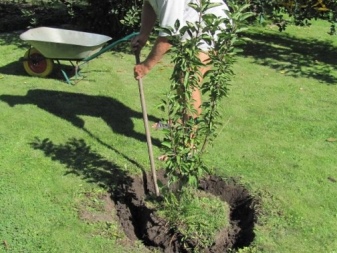

Follow-up care
The pear crop must be cared for in order to obtain the desired results.
- Watering. The plant is watered immediately after planting, then they do it regularly once a week (3 buckets each). If it rains, watering is often unnecessary. After each watering, the area near the trunk is covered with mulching material.
- Soil care. It is recommended to loosen and weed the soil every week. If the soil near the trunk settles, you need to top up the fertile soil. Lack of soil at the roots leads to drying out, and excess - to the appearance of diseases.
- Pruning. Pruning of long branches begins in the second year, and it is carried out before the onset of frost. Traces from the cuts are treated with garden pitch.
- Shelter. Usually young plants are covered. The crown of the tree is wrapped in burlap, and the trunk is wrapped in spruce branches. This procedure protects the tree from freezing.
- Fertilizers. Mineral fertilizers are applied during planting, and nitrogen-containing fertilizers are applied in spring. Additional fertilizing begins at fruiting (in the third year of life).
- Protection from pests. Trees are sprayed with a urea solution (700 ml per 10 l of water) once a year (in October or November). Also, for prevention, they whitewash the trunks and wrap the tree trunks.
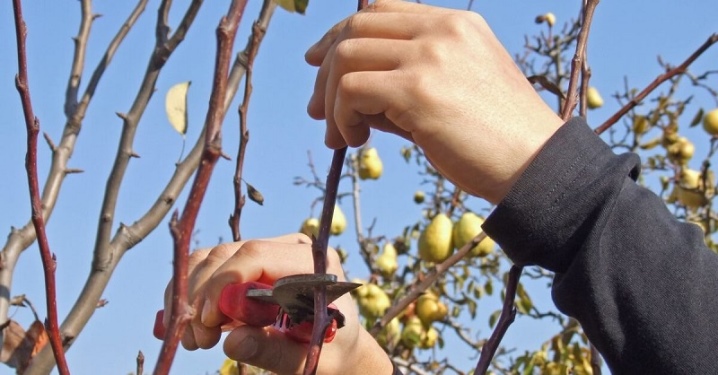
Useful Tips
In order not to be mistaken with the choice of a pear tree seedling, you should responsibly approach the purchase. It is best to choose trees in the nursery, while it is important to inform the sales assistant about the specifics of your garden plot: climate, type of terrain and soil. For planting, young seedlings are preferred - 1 or 2 years. The trunk and roots must be free of breaks, cuts or rot.
For seedlings in a container, it will be extremely difficult to inspect the roots, so you need to carefully assess the condition of the branches (inspection for the presence of living buds) and the trunk.
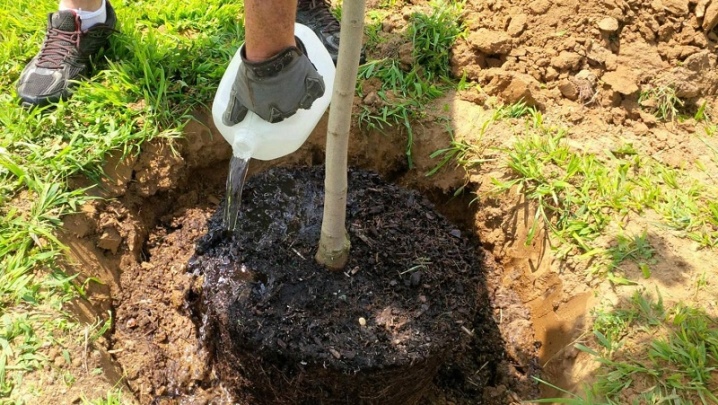









The comment was sent successfully.